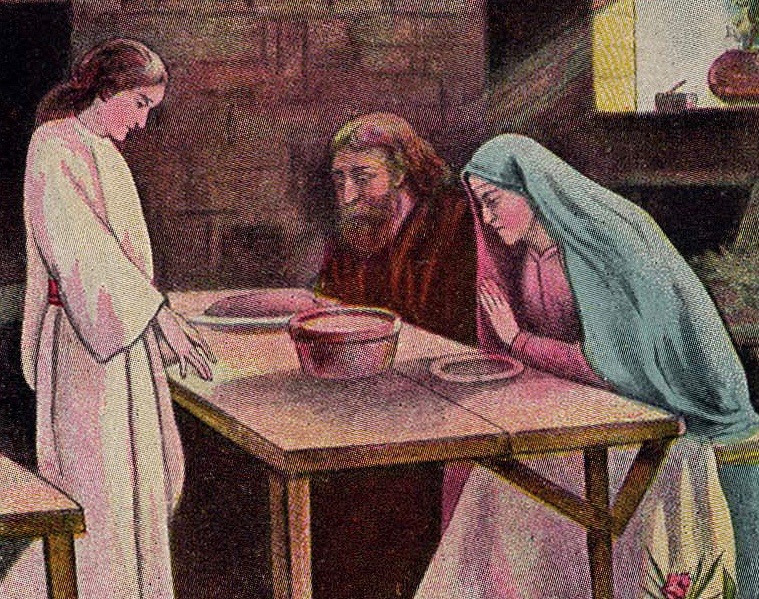Bread as a symbol is an important example of a “Consumption Motif” in Jewish Art and Religion, where Jew or Jewish God is posited as consumer and Aryan or non-Jew is posited as consumable resource, food or fuel. Hence it is worthy of closer review. Here, amazingly as well, there appears a sense of breeding or cultivating an Aryan host toward a stage of “Consumption.”
In my estimation, this metaphor is doubtless related to the Aryan figures of Ceres and Kore, who are best understood as wheat Gods. While certainly its earliest inspiration is owed to figures like Ninlil in Mesopotamia,[1] in the Greco-Roman myth, the symbolism is refined. Hence it is most useful to focus there.
Indeed, there, particularly through the mythology surrounding the subversive Eleusinian Mysteries, we find Kore’s abduction by the Semitic Pluto. Doubtlessly this, akin to Enlil’s seduction of Ninlil, describes a Jewish or proto-Jewish sexual competitor obtaining Aryan breeding stock. Certainly, as well, these metaphors are close to the metaphor of the Jewish Saturn as reaper or harvest God.
The most salient appearances of bread in Jewish Art and Religion are, of course, the Unleavened Bread appearing in the Exodus narrative and the Bread appearing in Christ’s Eucharist. In both cases, bread, as a symbol, functions as a metaphor for the host population as consumable resource.

The reader will remember during the Last Supper Christ “took bread, spoke a blessing and broke it, and gave it to the disciples, saying, ‘Take and eat; this is My body.’”[2] Christ is certainly a Jewish figure, as this book explicates, and, as a figure, represents a twist on the Consumption Motif. Here, though, we understand that the “Wine Blood” in the Eucharist is the masculine Semitic element, representing Bacchus, while the “Bread Body,” the feminine Aryan element, representing Kore.
To be clear, that Christ’s body is bread, an Aryan element, and his blood wine, a Semitic element, does not in any sense refute Christ’s Jewishness but rather, quite the contrary, helps us understand Jewishness. Here we see the Jew as the definitive, admixed type or “The Great,” as Jewish esotericists categorize it. This is also the meaning of the ecclesial concept of “Communion” which is “an act or instance of sharing.”

Here the Aryan Bread and Semitic Wine are admixed through a ritual consumption. Likewise, there is suggested here, a possession over Aryan “bread” or flesh as well as Jewish “wine” or blood. The eating of unleavened bread in Genesis 19, where Lot share’s the food with two angels that I posit as homosexuals or catamites,[3] suggest that it is a metaphor that extends beyond reproductive sexual activity.
The Hebrew too appears to corroborate bread as an Aryan element. For instance, we find the word Layish, לַיִשׁ which means both “dough” and “lion” in Modern Hebrew. The lion we understand to be a fundamentally Aryan symbol in the JEM. Again, this seems confirmed for instance in the Hebrew word Ari, אַרִי, which means both “Aryan” and “lion.” Here, though, “dough” gives us something more specific than bread. Rather it gives us a “pre-bread phase” and this would seem to fit with the “leavening” metaphor that appears in, for instance, Exodus. Yiddish seems to give us similar suggestion.
For example, there the Yiddish word leyb, לייב is the word for “lion” but also for “flesh.” Here, with the concept of “flesh,” the suggestion of “race” is even stronger. Likewise, we will find examples as well in the Hebrew were “flesh” and “bread” might be understood synonyms and even interchangeable. The word lechem, לחם, for instance, is translated as “bread” but also “meat” from the Hebrew Bible. Meaningfully this is the word for bread that appears in Bethlehem, בית לחם, Christ’s supposed birthplace, which means “House of Bread.”
Bethlehem means either “house of bread” or “house of flesh” and should be understood esoterically as a reference to a whorehouse. Indeed, beth or bet is twice translated “daughter” or “girl” in the Hebrew Bible and is close to bat, meaning “daughter” or “girl” as this study covers. Thus Bethlehem becomes even more suggestive. Here Jews are, remarkably, inhabiting an Aryan flesh that is metaphorically a temporary “house.” Here Jews are reproducing through this flesh and camouflaging or hiding within it.

Here it is useful to return to that curious Purim ritual of eating Hamantash, המן טאַש. Here, interestingly, Haman, המן, the name of an archetypal Aryan competitor also means “manna.” In the Bible this is a somewhat vaguely understood edible substance that permits the survival of the Israelites during the Exodus.
However there is reason that one would connect it to the symbol of bread if also other “Consumption metaphors.” For instance, another expression for manna, bet shamayim, לֶחֶם שָׁמַיִם, translates as “the bread of Heaven.” “Manna” as a concept, coming from “heaven,” might be taken as emphasizing a nobility or highness to this “bread” or “flesh” in a manner akin to Layish, לַיִשׁ, which, again, means “lion” and “dough.” This reminds us of the Samson parables, where Samson, an Aryan figure in the service of Jews, slay a lion. A bee nest later grows in the lion’s carcass, producing honey. Samson’s riddle describes the Aryan made resource: “Out of the eater, something to eat; out of the strong, something sweet.”
On the other hand, Dagan shamayim, דְגַן שָׁמַיִ, another Hebrew expression for “manna,” means “A fish” or “ambrosia.” All of these may be understood as “Consumption Motif” symbols. All might therefore be understood as metaphors for desired, “consumable” Aryan breeding stock as this study will explicate.
Of course, the real key to bread as a metaphor is alluded to in Exodus. Here we understand the process of “leavening” bread as a metaphor for the process of corrupting an Aryan stock for the purpose of “consumption.” In a sense, it describes a corruption of breeding.
Indeed, I would posit, the English word “bread,” via “Promethean Transmission,” may share its similarity to the word “breed,” precisely because the word “breed” may have developed with the Biblical metaphor in mind. Calvert Watkins, for instance, traces “bread” to the Proto-Indo-European root bhreu meaning “to boil, bubble, effervesce, burn” in reference to leavening. This is the same root to which etymologists trace “breed” with the more tenuous idea of incubation or animals warming eggs to hatch. Certainly, we understand there has been a corruption of breeding in Europe especially through the Christian period. There, metaphorically, Christian priests, crypto-Jews and otherwise, were “bakers” as well as vintners.
The Hebrew indicates that once a thing is “leavened” its fate is decided. We see this in the word la n’karatz’oth, לא נחרץ which means “unleavened” or “not determined.” N’karatz’oth, נחרץ, in contrast, means “decided” “resolved” or “fated.”[4] In Deuteronomy it is written “matzah, the bread of affliction; for you came out of the land of Egypt in haste. Thus you will remember the day you left the land of Egypt as long as you live.” [5]

Unleavened Bread is best understood as a metaphor for purer, less corrupted Aryan stocks. Hence eating unleavened bread is a reference to careful discernment of Aryan stocks within the context of the Semitic Bride Gathering Cult. Here the desire is for racially eugenic, sexually upright Aryan women.
In this metaphor, “yeast” or “leaven” clearly becomes the Semitic or Corrupting element or influence. In fact, yeast serves precisely the same purpose in the wine metaphor where it is also the critical agent in the fermentation process. The Modern Hebrew seems to confirm this.
There we find the word Sur, סוֹר, which means “leaven,” “fermentation” and “evil ways.” Hence by “evil ways” the Aryan dough is “leavened.” In the Bible, “leaven” or “yeast” does, indeed, become associated with sin. There, for instance, Christ says “Beware of the leaven of the Pharisees which is hypocrisy.”[6] Paul remarks of a church’s flock “a little leaven leaveneth the whole lump.”[7] Thus here again, esoterically, Jews imagine themselves, in some ways, as the Sumerian God Sin or Nanna, or rather, sin itself.
Likewise, yeast seems to function as a symbol of Semitic insemination or admixing with Aryan population. Here it’s necessary to understand that yeast is essentially old, fermented dough, placed in new dough so as to make it rise. Thus we are given a sense of a Semitic racial agedness, contrasting with Apollonian youth.
Indeed, with this understanding it appears that Christ tells a dirty Joke in Matthew 13:33. There he says, “To what shall I compare the kingdom of God? It is like leaven that a woman took and hid in three measures of flour, until it was all leavened.” The number three is a sexual reference in the numerology suggesting Semitic/Aryan intermixture as this study explicates. Hence here as well we understand the Christian conception of Heaven as intermixture with Aryan women, the Serpent with Eve in Eden.

The “kneading” of bread too appears in Modern Hebrew as a metaphor for the corrupting or Semitization of Aryans. There the word shalosh, שְׁלֹשָׁ֥ה, means “knead” but also “three hundred.” The reader will understand the reference to three as a reference to sexual interaction between Aryan and Jew. Here the Hebrew Bible corroborates. For instance, Biblical language indicating Jonah spent three days in the belly of the “Whale” or “Great Fish” use the word shalosh, שְׁלֹשָׁ֥ה, for “three.” There is certainly a sexual connotation here with the “Great Fish,” a Jewish figure, and Jonah, an Aryan figure, as this study explicates.
Hence the Modern Hebrew, consistent with the “leavening” metaphor, suggest the “kneading” of bread as a metaphor for the corruption or “preparation” of any “Aryan bread.” Shalosh is also used to describe the number of men (three) encountered by Abraham in Genesis 18:2, who together are understood to represent the Jewish God. As this study explicates, it is during this sequence in which it is esoterically indicated that Abraham has offered his wife to the Jewish God to impregnate. There as well Sarah is described as kneading three “seahs” of fine flour for the guests.
At last we find this fascination Hebrew expression ‘oklah lechem checed, אוֹכֵל לֶחֶם חֶסֶד. The expression means “eating bread” but also “parasite” in noun form. This conforms with our understanding of bread as a metaphor for the Aryan “host” or “person who receives guests.” This shouldn’t be surprising. To be sure, in JEM, whether contemporary or ancient, we will find Jewish Esotericists indicating Jews as devils, serpents, Bacchus the God of degeneracy, corrupting yeast, sin itself, consumers of Aryan flesh, terminal diseases and parasites.
This sense may even be gained from the proposed name meaning of Levi or Levite, the clan from whence, ostensibly, descended Jewish priests. Here Levi is often believed to mean “attached” or “joined.” Hence one does not get the sense of something essential or vital here, but rather something that is consciously dependent, “attached,” and, at best, superfluous. It reminds us as well of the name meaning of Jacob given in Hebrew Bible “holder of the heel.” It describes the proto-Jew’s relationship to his Aryan brother Esau.
These matters are discussed here:
[1] Ninlil is often understood as descended from, Nunbarsegunu, a barley Goddess and Haia, a God of stores… Hence, as discussed elsewhere in this study, she may be understood as an equivalent of Kore.
[2] Matthew 26:26
[3] Genesis 19:3
[5] Deuteronomy 16:3
[6] Luke 12:1
[7] Galatians 5:9
9 thoughts on “Bread as an important example of the “Consumption Motif””